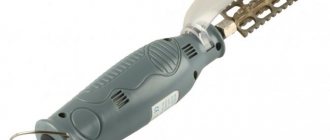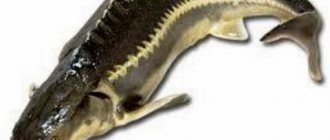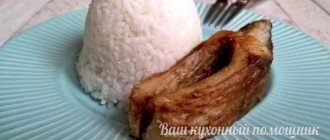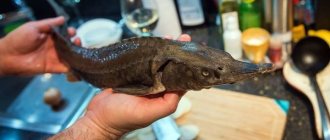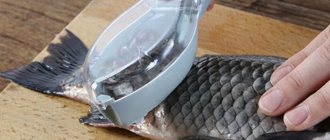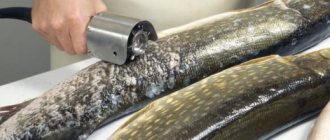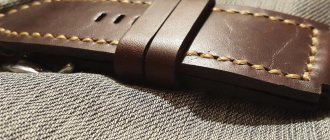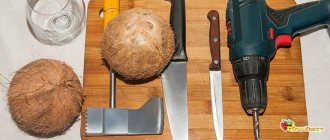Preparing fresh fish
Carp lives in fresh water bodies; most often this fish ends up on the table from a store or as a fisherman’s catch. If it was caught with bait, then the latter needs to be removed from the throat; this can be done by directing a stream of water there, which will wash away all the excess. You also need to remove the gills from the head, where bacteria begin to multiply first. All this is necessary if the preparation requires the presence of a head, otherwise it can simply be cut off later.
The carcass must be thoroughly washed to remove silt and the slimy coating that protects the scales. To do this, simply rinse the carp under running water. It is also worth cutting off the fins first so that they do not interfere when the time comes to clean the carp from scales. They can easily hurt you.
Removing fins
The fins can be cut with scissors, but it is better to remove them completely with a knife.
Instructions:
- Make cuts on the sides of the ridge.
- Gently pull it towards you and continue making slits until it is completely separated from the carcass.
- You can try to pull out the fins on the belly and near the head with your hands. If this does not work, then use a knife and make small cuts.
Be careful with the fins! They can seriously injure your hands.
Removing scales
At this stage, it is most difficult to clean carp, so you must know how to properly remove scales from the fish. It is best to use a special fish cleaning device for this. They have sharp serrations that easily separate even the toughest scales. Such devices are sold in stores or can be made independently.
During cleaning, the scales fly in different directions. To avoid this, housewives recommend cleaning in a basin of water so that the scales remain in it. Either place the fish inside the bag and put your hands in there to clean it inside, so all the cleaning will remain there.
Advice! To more easily and effortlessly separate the scales from the fish, it must be placed in boiling water. The time required to achieve the desired effect is no more than 1 minute, otherwise the carp will be cooked.
Scales from large fresh carp can be removed with a knife. To do this, place the fish on a cutting board and, pressing down on the tail, clean the carcass with sharp movements. But it is in this case that the housewife finds herself in a situation where, after she has cleaned the carp, she needs to clean out the kitchen. Therefore, the above measures should be taken.
Sturgeon
- Provitamin A is responsible for vision, helps to better navigate in the dark.
- Vitamin D - without it, calcium will not be absorbed, for healthy bones and teeth. It is also useful for the immune system.
- Tocopherol – renews skin cells, synthesizes hormones, for youth and beauty.
- Vitamins B 1,2,3,6,9,12 – benefit the hematopoietic and nervous systems, lower cholesterol and improve immunity, improve memory and mental abilities.
Among the types that are in demand in the kitchen, many have a powerful scaly coating that is easy to injure. Usually the fish is placed on a newspaper and the sticky scales are cleaned off with a knife, but this way they will fly in all directions. There are different ways to quickly clean carcasses without subsequent lengthy cleaning, some of them are better suited to certain varieties.
Features and value of carp
Carp is an artificially bred species of fish, the ancestor of which is the carp. The word "carp" comes from the Greek language and is translated as fruit. And for good reason: one female produces up to 1.5 million eggs. The Chinese were the first to breed domesticated carp. Historians believe that this fish began to be used as food back in 1000 BC. e. Carp dishes became a favorite treat for Chinese emperors. Later, fish began to be bred in other Asian countries and Europe.
Carp meat has great benefits for the body. It is very tender and sweetish in taste. The fat content of fish muscle tissue is lower than that of lean beef, which is important for people on a low-fat diet, as well as for children and athletes. Carp is a source of many important nutrients, proteins and omega-3 fatty acids. These unsaturated acids have a positive effect on cardiac function and help prevent cardiovascular diseases. Another feature of carp is its ease of digestibility, due to the special structure of muscle fibers.
It takes three or four years to grow carp in artificial reservoirs. Three-year-old individuals reach a weight of about 2 kg, and four-year-old individuals weigh more than 2.5 kg.
Carp is a domesticated form of carp
Appearance
Characteristics:
- Thick body of moderate length.
- Large, uniform, cylindrical scales with a characteristic edging on the sides.
- The sides are brown or golden yellow.
- Double nostrils.
- He often pulls his mouth into a tube.
- Small mustache above the upper lip.
- The eyes are set high, the pupils are small.
- Dark back with characteristic gray-olive fins.
- In adult specimens, brownish, gray and dark gray tones predominate in the general color.
- There are individuals that have no scales. This variety is called naked carp.
Carp is a freshwater fish; it comes to the table either from the store or by catching it yourself from a reservoir. It can grow up to one and a half meters. This fish lives in rivers and lakes, and is found in ponds, reservoirs, and artificial reservoirs. It is almost impossible to find it in the ocean and in the sea. This is due to the fact that it is not able to live in salt water.
Cleaning and cutting of carp
Currently, a huge number of recipes for cooking carp have been invented. It is baked with a side dish of vegetables, potatoes and cereals, and also boiled with spices, stuffed in various ways and simply fried in vegetable oil until crispy. On store shelves you can find gutted frozen fish, fillets and ready-made semi-finished products. But you'll get the most benefit from fresh or live carp. Don't be afraid of the upcoming hassle with cutting the fish. Having mastered a few simple rules, you can easily turn live carp into a culinary masterpiece.
The most common carp on sale are common and mirror carp. The latter is a little easier to clean, due to the fact that its scales are large and not very tightly pressed to each other. With common carp you will have to tinker a little longer.
What you need for work
To properly and easily clean and cut fish you will need the following tools:
You also need to prepare:
Step-by-step instructions for cleaning, gutting and cutting carp
Some housewives clean and cut fish in the sink
To prevent the fish from slipping out of your hands, wear work gloves
Remove scales using a scraper
Cut the carcass along the belly and remove the entrails
Remove the head or take out the gills
How to skin a whole carp - gallery
How to fillet fish
When cutting carp into fillets, you need to separate the meat from its inedible parts: skin, spine, bones. To do this, it is not necessary to first gut and scale the fish.
To fillet carp, you need to make an incision along the gills of the fish.
An incision is made from the side of the dorsal fin before the incision along the gills
In the tail part of the carp carcass you need to cut through it with a knife
When separating the meat, the ribs do not need to be cut off: they should remain on the backbone
You need to remove the fillet first from one side, then from the other.
Make a cut in the middle of the fish up to the skin to remove it
After separating the carp meat from the bones, you need to remove the skin.
The art of cutting carp - video
Now you can easily diversify your family’s diet with carp dishes. The described instructions will help you quickly and correctly clean and cut fish that is very tasty and rich in nutrients.
Source
What dishes are prepared from salmon?
Thanks to its amazing taste, people have come up with many recipes. Therefore, among this variety you can find salmon baked with beans or peas. When preparing such a dish, you do not need to get carried away with adding liquid, as the salmon meat may fall apart. It is enough if the liquid only covers the bottom.
A wonderful and healthy dish is a salad of salmon and fresh vegetables. It is very important that the product is chilled. Fish goes well with any side dish or potatoes. You can cook a lot of dishes with salmon, as it goes well with almost all foods. In addition, this fish can be eaten without side dishes, as an independent product, due to its exquisite taste.
Salmon (or salmonids) is a fairly valuable product, and also very healthy. It is enough to eat one piece of meat and you can replenish your body with a whole bunch of useful substances.
How to cut carp for frying
Cutting a fish is a real art. Everything unnecessary must be removed. In this case, you must not damage the skin of the fish so that it does not fall apart in the pan and looks beautiful on the plate. How to fillet fish correctly?
Gut the carcass in advance, remove the scales, remove the gills. Then start filleting the carp.
Use scissors to cut off all the fins of the fish. Try to cut the fins so that the root of the fin remains. This is necessary so as not to cut through the fish skin or damage the integrity of the future fillet.
Cut off the carp's head diagonally, as if in a circle, so that less flesh remains on the head.
Start with the abdomen. Cut through the carcass to the spine, then turn the fish over and cut through the flesh from the other side to the spine. Hit the back of the knife blade several times with your palm, it will cut the spine and separate the head of the carp.
Cut off the fish tail.
How to remove bones when cutting?
Without removing the first fillet, make a cut on the other side of the spine, deepening the cut, cutting through the small bones.
Turn the carcass, place the blade flat on the side of the head. Raising the fillet slightly, cut the first rib bone with a knife. When chopping thick rib bones, run the knife along the entire length of the fish. Cut the second fillet in the same way.
Set aside the ridge. The fins, the ridge, the head will go to the ear.
Set aside the rib portion. There are many small seeds in it, running in three rows. It is best to pass two rib parts through a meat grinder three times. The bones will remain inside the meat grinder, and you will get excellent minced fish.
There are many small bones in the tail section. Therefore, cut off the tail and make several crosswise notches on it. It is good to fry this piece in a large amount of oil so that the bones become crispy.
A piece of fillet from the costal line to the belly contains practically no bones, it is ideal for frying or baking. This is how you can effectively cut up carp for frying.
If you don’t have time to carefully fillet the fish, make notches on the fish, then fry the carp.
Source
Gutting
Yandex.Pictures
Quite often, housewives neglect safety precautions and face various injuries. In such a matter, it is important to be extremely careful. At first glance, it seems that the process of removing scales is a harmless matter, but it is not so:
- When cutting, you should not rush, otherwise you will end up with a fish rib driven into your hand. Quite often, when cutting up a carcass, housewives accidentally drive a bone into their hand. This may happen due to the hand slipping or other reasons. But the fact is that the moment the rib penetrates the skin of the arm, it can break and remain there. Then you will not be able to remove the foreign body yourself, since you will have to make an incision and remove the bone. Acute pain sensations are guaranteed. Therefore, be extremely careful.
- You can often cut your hand while cleaning. This is due to the fact that housewives begin to quickly remove the scales, holding the carcass by the tail. Although the knife is angled and in the opposite direction of the hand, the edge of the tool can catch fingers and cause serious injury. For this reason, near the tail it is necessary to slow down and complete the work with special care.
- As a rule, during processing the scales fly in all directions. Therefore, very often fish particles get into the eyes. Of course, you shouldn’t perform such manipulations with glasses, but precautions won’t hurt. It’s better to put the product in a bag or in a container with water and process the carcass. If a particle does get into the eye, a burning pain will occur, which will subside only after a couple of days.
Removing fish scales is a nasty task and is considered one of the dirtiest procedures in cooking. But with experience and the right tools, the cleaning process will be reduced. To avoid harming yourself, follow safety precautions and take your time. Then the risk of injury will be significantly reduced.
How I found my ideal hair growth product
Hello dear! I want to share with you my solution to the sensitive problem of hair loss . The problems are very serious, at least for me. I would never have thought that this misfortune would touch me, especially at the age of 29 (read more...)
Carp cutting
1. So, running a fish knife horizontally along the dorsal fin, carefully separate the upper half of the fish from the ridge and turn the fish into a butterfly.
Using a fish knife, cut the fish horizontally along the dorsal fin
2. Lifting by the tail, separate the entire ridge along with the ribs. This way you will remove all large bones. The back of the carp - the part that is located above the midline, also has its own midline, separating two longitudinal muscle groups. It is along this line that these thymus bones are located, supporting the uppermost group. If you now run the knife vertically along the back, approximately in the middle, you will be able to push these two muscle groups apart and the bones will stick out in the middle.
Divide the back fillet approximately down the middle so that the bones can be removed.
3. The bones can be decisively and quickly removed with fish tongs or tweezers, they will be clearly visible. After this, you can eat the carp without spitting and without fear. Try it, it's not as difficult as it might seem.
Bones are best removed with tweezers.
We cut the carcass
Having ensured that both sides of the carcass are thoroughly cleaned, you can begin cutting it up. To do this, you need to put it on a cutting board and cut into the abdominal cavity. From there, you should carefully remove the entrails so as not to damage the gall bladder, otherwise it will ruin the taste of the meat.
And it is also important to remove the dark film that covers the abdominal cavity from the inside. Cut off the head. After this, the fish must be thoroughly rinsed under running water. If the dish requires it, you can separate the fillet from the bone. To do this, you need to make cuts parallel to the spine, reaching the ribs without damaging them. Then run a knife under the ribs to remove the flesh from them. After this, cut the fillet from the tail section.
Now this process will not cause any difficulties for anyone. And everyone can enjoy this delicious lake fish.
Cooking carp
1. Scale and gut smaller fish,
Clean and gut the carp
2. Cut large fish into 2-3 cm slices and then gut them
Cut large fish into slices
3. Remove the fillet from the smaller one and chop it. Mix chopped fillet with white bread soaked in milk and fried onions, butter, raw eggs, beat well.
Baking carp
I really like to bake large mirror carps weighing 2 kilograms or more. This is the easiest method and one of the most delicious; the fish turns out to be as juicy and tender as possible.
1. A whole carp needs to be gutted without peeling the scales, rub the inside with salt, put a bunch of greens and a few slices of lemon in the belly, rub the outside with honey, paprika and olive oil.
Gut the carp, rub the belly with salt and add lemon slices
2. Cover a baking sheet with baking paper, place the carp and salt the scales on top. Preheat the oven to 180C with convection and place a baking sheet with carp in the middle of the height. Bake for approximately 30 minutes.
Bake the carp for about half an hour
3. Remove the finished carp from the oven and set aside on a baking sheet.
. cover with foil and let stand for 5-10 minutes.
Remove the finished carp from the oven, cover with foil and let stand for 10 minutes.
4. Serve carp with fresh or baked vegetables.
Serve cooked carp with vegetables
Carp in beer
1. The carp needs to be gutted.
Gut the carp before cooking
2. Next, clean the fish from scales (the sequence is exactly this - if you peel off the scales from an ungutted carp, there is a high risk of crushing the gall bladder and all is lost; in general, you should gut river fish carefully), you can leave it whole or immediately cut large fish into portions.
Remove scales from fish
3. Place a bed of chopped onions and roots on the bottom of the pan, place the carp on top, add ten grains of black and allspice, a bay leaf, pour in beer until just covered, and put on medium heat. Once boiling, reduce heat to low and simmer for about 10 minutes.
Place the carp on the bottom of the pan, pour in beer and put on fire
4. Then the pieces of carp or whole fish are transferred to a dish.
Place the carp on a plate
Prepare the sauce
5. Strain the finished sauce and pour it over the fish on a platter. Anyway, it's beautiful.
Pour the prepared sauce over the fish
Source
